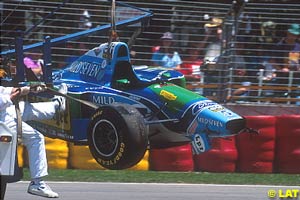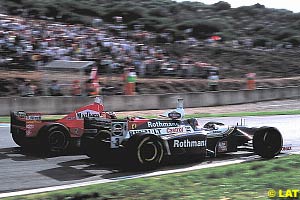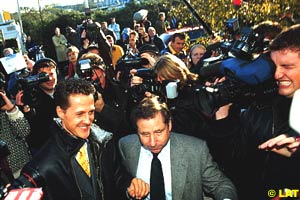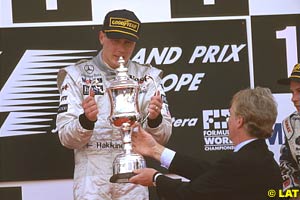
Atlas F1 Senior Writer
Alongside on-track racing, Formula One is as much about the off-track politicking and regulation challenges. Seeing the competition decided in court has become very much a fixture of this sport as pit stops or on-track passing. But how do the wheels of justice really turn in Formula One? How did it work in the case of Jordan and Jarno Trulli at the 2001 US Grand Prix? Or in the case of Michael Schumacher and the Benetton team in 1994?
Atlas F1's Thomas O'Keefe brings an unprecedented study on the FIA's justice system and its very own Court of Appeal. In a four part feature, he reveals never-before-published evidence on how this unique system works
Who better to be a barometer of Racing Justice than Michael Schumacher, who has during his rich and storied career felt both the sword and the shield of the FIA's judicial system? Some of the controversies he has been involved in have risen to the level of scrutiny of the Stewards, the FIA's International Court of Appeal, or the FIA's World Motor Sports Council, while other episodes were never actually litigated but remain the subject of controversy.
Although Jarno Trulli at Indianapolis 2001 was the most recent driver cited for skid block nonconformance, Michael Schumacher was an early victim of the rule, back in his first Championship year with Benetton-Ford in 1994. It was a season of death at Imola and disqualification practically everywhere else. Indeed, Schumacher and his team were penalized so many times for so many things in 1994 that it is a wonder Schumacher actually eked out the World Championship over Damon Hill by one point.
The post-race technical inspection showed that the plywood skid block had been partly shaved off, thus lowering the ground clearance of the car and theoretically giving the Benetton a performance advantage as to ground effect. The skid block rule was a relatively new one at that time, having been introduced only two races earlier at Hockenheim for the German Grand Prix. It would not be the only time a sanction would cost Schumacher a victory.
To this day, it stings ex-Benetton mechanic and current F1 commentator Steve Matchett to recall the unfairness of the sanction, since the gash in the skid block plank was caused by a spin on the kerbing. "We had video footage obviously from the cameras of Michael in the 360 degree spin over highly serrated kerbs at Spa," he recalls, but the FIA Stewards, according to Matchett, claimed not to have had evidence of an accident occurring on that lap.
Interestingly, only two days after this skid block infraction had occurred in Belgium, the Court of Appeal convened in Paris to deal with another episode that had happened a month earlier at the British Grand Prix, where Schumacher and Benetton were accused of blatant disregard of the most fundamental of signals from corner marshals to driver: the black flag.
The black flag matter started innocently enough, with Michael (who had qualified second fastest) passing pole sitter Damon Hill on the parade lap of the British Grand Prix at Silverstone. Following that, a five-second penalty in the pits was imposed by the Stewards. As it happened, though, the race officials took their time in issuing the five-second penalty, and what should have been a five-second penalty mushroomed into a two-race disqualification because of how the Benetton team mishandled the situation.
When the black flag finally came out on lap 17 or so of the 60 lap race, while Michael was leading, Schumacher ignored the flag for the three laps it was displayed, later claiming he had not seen it. In the strongest terms, the Court of Appeal rejected any and all of Schumacher's defense claims:
WHEREAS, these arguments cannot for one moment be accepted,
WHEREAS, this prescription is purely formal and does not efface the infringement itself which still remained, as the notification had merely been given belatedly,
WHEREAS, in any case the black flag had been shown for a penalty which had manifestly been incurred, and the showing of this flag should have been respected, as should the notification of the penalty,
WHEREAS, in effect the fact of allowing a driver to be the judge of the regularity or irregularity of a penalty imposed during an event would ruin all sporting discipline, all spirit of competition and all competition itself,
WHEREAS, whatever the reason, regardless of the notification of the penalty, the black flag indicating an imperative stop was shown and was not respected, in breach of Article 4, paragraph 1.1, penultimate sub-paragraph of Appendix H, an infringement deemed as such by the World Motor Sport Council when in the case in point the driver, disregarding an imperative order to stop, which could just as well have been given for safety reasons, preferred to ignore it and stopped only on the instruction of his team,
WHEREAS, although the team is responsible for the instructions which it gave to its driver and which were contrary to the Regulations, the driver is not the subordinate of his team but has a certain liberty which, moreover, is required by the Regulations which he has accepted, and must himself, along with the team, take responsibility for deliberate faults, particularly with regard to the observation of the regulation signals, and his arguments should not for one moment be accepted,
WHEREAS, during the present hearing, the driver Schumacher admitted having seen the number 5 board, and whereas his argument that he did not see the black flag is unacceptable given that the black flag was shown at the same time as the number 5 board,
WHEREAS, furthermore, the black flag was shown during three laps to a driver who had already been informed that a penalty had been declared against him, and whereas the driver is therefore especially guilty of failing to respect this flag and cannot seriously claim that he did not see it.
In any event, the FIA came down like a ton of bricks on Schumacher and not only disqualified Schumacher from his British Grand Prix victory but suspended him from participation in the next two Grands Prix. It was almost as if the FIA was saying to Schumacher: you ignored three black flags, you forfeit three races. This decision, dated August 30th 1994, would have daunted and chastened lesser men but not Schumacher.
Although Schumacher has always been known for playing hardball on the racetrack, it was this extraordinary spate of penalties imposed on him in 1994 that began to give Schumacher the reputation of one who skated close to the edge.
The most enduring example of this reputation is the "Schuey Chop" - or "One Move" Rule as it is called - his trademark way of making up for his traditionally poor starts (at least before Launch Control) by swerving once in front of his opponents. Indeed, even Michael's brother Ralf has felt the fumes from the Ferrari "cats eyes" exhausts while being squeezed to the pit wall on the front straight at the start of the 2001 European Grand Prix at the Nurburgring.
While Michael Schumacher is often blamed for the One Move Rule, the origin of the species is not the resourceful and creative Schumacher but a decision announced on overtaking years ago by none other than the World Motor Sports Council, a kind of Board of Directors that sets policy for the FIA.
Appendix L to the International Sporting Code, Chapter IV ("Code of Driving Conduct on Circuits"), Article 2 states the rule:
As the World Council explained on October 19th 1995, this Overtaking rule "will be enforced by the Stewards in Formula One on the basis that drivers are free to drive as they wish provided they do not deliberately endanger another driver or repeatedly obstruct him on a straight."
The word "repeatedly" is apparently the source of the One Move Rule. In commenting on this rule, the President of the FIA, Max Mosley, said at the time: "Racing is different to the road in one sense - when competing, you drive to the limit of your abilities. We held a meeting earlier this month with leading Formula One drivers and they agreed that no driver should endanger another driver but otherwise should be allowed to compete freely. The World Council has accepted this view. The drivers are top professionals so we will let them get on with it."
Towards the end of the 1994 season, Michael was going for his first World Drivers' Championship, driving for Benetton-Ford, and he and Damon Hill, driving for Williams-Renault, were neck and neck going into the Australian Grand Prix at Adelaide, the last race of the season. On lap 35, Schumacher, while leading, slid off course into the grass and touched the wall with his right front wheel, damaging his car, but was sufficiently ahead of Hill to clamber back onto the track in his crippled Benetton just in time to attempt to take the next corner ahead of Hill, who was now closing.
Hill turned in as if it was "his" corner and the two cars touched. Schumacher's Benetton upon hitting the Williams went up on two wheels, Hill was unable to continue and Schumacher won the race and the Championship at that moment. Schumacher got away with the "Closing the Door" maneuver against Hill at Adelaide, which NASCAR drivers would have called "a racing deal," and no FIA action was taken.
But when Schumacher tried a similar defensive move to blunt a spectacular come-from-behind overtaking maneuver by Jacques Villeneuve at the European Grand Prix of 1997, the FIA stepped in and the official record of the charges and sanctions against Schumacher is firm, terse but ambiguous all at the same time.
It is interesting to note that the Stewards of the Meeting never brought charges against Schumacher, saying that they "unanimously concluded it was a racing incident and no further action is necessary." As a result, the World Motor Sports Council took the matter up upon its own, sua sponte.
The FIA's records show that following a report from the FIA Race Director, on October 27th 1997, the FIA "summoned Michael Schumacher to appear before an extraordinary meeting of the FIA's World Motor Sport Council" in London on November 11th 1997. Since Villeneuve had wrapped up the Championship by then, this was all post-season.
On November 11th the FIA announced its findings as to the then two-time World Champion after hearing Schumacher's testimony. The World Council's official conclusions after the hearing were as follows:
Michael Schumacher's maneuver "was an instinctive reaction and although deliberate not made with malice or premeditation. It was a serious error. The World Council decided to exclude Michael Schumacher from the results of the 1997 FIA Formula One World Championship for drivers. The final results of the FIA Formula One World Championship have been modified accordingly. The results of the Constructors' Championship remain unchanged. Michael Schumacher retains his points and victories recorded during the 1997 season. In lieu of any further penalty or fine, Michael Schumacher agreed to participate in the FIA European road safety campaign for a total of seven days in 1998."
"Schumacher did the wrong thing, obviously, but all the evidence points to him reacting instinctively. Had he thought about it, for one second, he would have allowed Villeneuve through. Schumacher is a human being and every now and then he will make a mistake. He admitted he did it deliberately, but instinctively, and it was the wrong thing to do."
As with the Adelaide Hill/Schumacher 1994 incident, controversy continues to this day as to the merits of the Villeneuve/Schumacher 1997 incident. The remarks of the drivers at the time are revealing. Looking cool, calm, collected and cocky in the post-Jerez press conference, having finished in third place, the newly-crowned Villeneuve (then in his blonde era) gave his version of the Incident at Dry Sack corner, perhaps an hour after the incident had occurred:
The way he hit me was really really hard. I'm surprised that I could actually finish the race. I couldn't go more on the inside. I was actually on the grass so
either Michael had his eyes closed or somehow his hands slid on the steering or something."
Schumacher was not on the podium, but here are his remarks the day after the Jerez race:
But by the very next day, on Tuesday October 28th, Schumacher had gotten religion and given the matter further thought: "I am human like everyone else and unfortunately I made a mistake. I don't make many but I did this time."
As to his firm reaction to the contrary after the race he explained that "not everything was clear to my mind then. There is no point in saying I would have done the same. That is wrong
my reaction for sure in the future would be different. You are so determined to fight and do your best. I took a wrong judgment. I will have to live with the consequences of this."
And indeed, Mika, hungry for his first victory, was in hot pursuit. Then, as Hakkinen chased Villeneuve down the front straight on the final lap, it became clear that Jacques was struggling with the Williams and let Hakkinen by at the chicane and then let Coulthard by as well, thus giving Mika Hakkinen his first win and McLaren-Mercedes their first 1-2 result since 1991. Watching this series of events was thrilling if bizarre but by the end it became obvious that this finish must have been orchestrated behind the scenes by the McLaren and Williams teams as payback, one team to the other, for prior favors.
It is interesting that the Ferrari team, which had something of an interest in this matter, reportedly had tapes of conversations between Villeneuve and the Williams pit which seemed to indicate that Villeneuve had let the McLarens past on order, but all sides denied an agreement. Furthermore, as part of its wrap up of Jerez 1997, the FIA's World Motor Sport Council took under advisement what it called "alleged collusion between West McLaren Mercedes and Williams Grand Prix Engineering concerning the result of the 1997 European Grand Prix." On this incident, the FIA heard the explanations of the team, threw up its hands and plainly decided simply to look the other way, concluding that, "the West McLaren Mercedes and Williams Grand Prix Engineering were able to show that there was no arrangement to fix the results of the 1997 European Grand Prix."
For the future, however, and in order to avoid possible misunderstanding and ambiguities, the World Motor Sport Council recommended that all radio transmissions between drivers and their pits should be freely accessible by journalists and the public. Nonetheless, don't bother going out to Radio Shack to buy a radio scanner just yet to listen in on Ross Brawn and Michael Schumacher kibitzing throughout the race. The recommendation of open access for radio transmissions has not been followed, though the occasional voluntarily supplied transmissions are made available to the public over the Digital TV feed.
Not content with disciplining Schumacher and letting the Williams and McLaren teams off the hook for a curious form of Team Orders, the FIA had one more object of sanction at the Jerez 1997 race.
In December 1997, the FIA sanctioned the mayor of Jerez, Spain, Mr. Pedro Pacheco, for "certain incidents" which occurred during the podium ceremony of the European Grand Prix. We have rules for the podium ceremony and presentation of the trophies too, Rule 170 and Appendix 3 of the F1 Sporting Regulations.
Called into the dock, Mayor Pacheco, like Michael Schumacher, was invited to appear before the World Council in London, clarified what occurred and "explained that there had been a misunderstanding and that the World Council could be assured that this would never happen again."
What was this sideshow all about? It seems that the podium ceremony was disrupted by Mayor Pacheco and other local government officials jockeying for position and visibility at this widely televised moment. "The disruption caused embarrassment and inconvenience to those presenting the trophies," according to a report from the World Council's meeting on December 12th 1997. In any event, the World Council accepted Mayor Pacheco's explanations and the sanction imposed on Jerez was removed.
All's forgiven? Curiously, 1997 was the last year Formula One ran a Grand Prix at Jerez de la Frontera; as Mayor Pacheco said: "It won't happen again."
 In the first skid block case, Schumacher had his win at the Belgian Grand Prix taken away when his wooden skid block (which was supposed to be at least 300 mm wide and 10 mm thick) was found to have been worn down below the permitted tolerance of 10% reduction in the thickness.
In the first skid block case, Schumacher had his win at the Belgian Grand Prix taken away when his wooden skid block (which was supposed to be at least 300 mm wide and 10 mm thick) was found to have been worn down below the permitted tolerance of 10% reduction in the thickness.
WHEREAS, in effect the driver Schumacher, both himself and through his Counsel, claims various possibilities, namely that the Stewards of the Meeting had applied the Regulations incorrectly during the formation lap, that there was prescription concerning the penalty imposed and that the team was responsible in any case since the driver had not deliberately disregarded the black flag which he said he had not seen,
 Incredibly, on another occasion during that same 1994 season, the Benetton team was fined $500,000 because the team was suspected of using a forbidden launch control system and had failed to make its software available in a timely way to race officials after the Grand Prix of San Marino.
Incredibly, on another occasion during that same 1994 season, the Benetton team was fined $500,000 because the team was suspected of using a forbidden launch control system and had failed to make its software available in a timely way to race officials after the Grand Prix of San Marino.
"OVERTAKING
a) during a race, a car along on the track may use the full width of the said track. However, as soon as it is caught up on a straight by a car which is either temporarily or constantly faster, the driver shall give the other vehicle the right of way by pulling over to one side in order to allow for passing on the other side. However, manoeuvres liable to hinder other drivers such as premature changes of direction, more than one change of direction, deliberate crowding of cars towards the inside or the outside of the curve or any other abnormal change of direction, are strictly prohibited and shall be penalised, according to the importance and repetition of the offences, by penalties ranging from a fine to the exclusion from the race. The repetition of dangerous driving, even involuntary, may result in the exclusion from the race."  So Michael it seems has had semi-official sponsorship for his sometimes controversial moves. But there is no question that Schumacher is always out there testing the confines of the legal envelope.
So Michael it seems has had semi-official sponsorship for his sometimes controversial moves. But there is no question that Schumacher is always out there testing the confines of the legal envelope.
 Max Mosley elaborated on the thinking of the World Council, commenting as follows: "It was an instinctive reaction. If we thought it was premeditated then we would have to take a very serious view. It is still a very serious matter and it is a major penalty we have imposed. In this particular instance, both Villeneuve and Schumacher were under enormous pressure. They had one point between them, they had people shouting in their ear 'he is just one second behind you' and the pressure, in those circumstances, is enormous.
Max Mosley elaborated on the thinking of the World Council, commenting as follows: "It was an instinctive reaction. If we thought it was premeditated then we would have to take a very serious view. It is still a very serious matter and it is a major penalty we have imposed. In this particular instance, both Villeneuve and Schumacher were under enormous pressure. They had one point between them, they had people shouting in their ear 'he is just one second behind you' and the pressure, in those circumstances, is enormous.
"I was a little bit worried 20 laps from the end because when I overtook Michael
Well I wasn't really surprised when he finally decided to turn in on me
it was a little bit expected so I knew I was taking a big risk. But when he turned on me we banged wheels and I jumped in the air and I really thought I had broken the car. Luckily he went off and my car felt very strange, the rear end
"Jacques cut in and didn't try to brake at all. Certainly, I closed the door. It was clearly about winning it all or nothing and there was nothing more to lose. Without me, Jacques would have more or less driven into the gravel pit. That's why I don't quite understand the situation now."
 As with Indy 2001, the Jerez 1997 race was riddled with faux pas. Toward the end of this same race, Jacques Villeneuve, nursing a crippled car from his crash but with Schumacher out and the 1997 World Drivers' Championship secure, slowed dramatically in the last three laps of the race. Soon thereafter, David Coulthard moved over and let his teammate Mika Hakkinen by pursuant to internal team orders. Coulthard explained later that Mika was faster at that point of the race and he let him by to give him a shot at catching Villeneuve in the closing laps.
As with Indy 2001, the Jerez 1997 race was riddled with faux pas. Toward the end of this same race, Jacques Villeneuve, nursing a crippled car from his crash but with Schumacher out and the 1997 World Drivers' Championship secure, slowed dramatically in the last three laps of the race. Soon thereafter, David Coulthard moved over and let his teammate Mika Hakkinen by pursuant to internal team orders. Coulthard explained later that Mika was faster at that point of the race and he let him by to give him a shot at catching Villeneuve in the closing laps.
 The podium ceremony was a unique one, with much to celebrate: Hakkinen's first victory and Villeneuve's Championship. Even Max Mosley was on the podium to hand the trophy to the boyish-looking Canadian that he had sparred with all season long as the Pecks Bad Boy of the FIA. In full view of Max Mosley, Mayor Pacheco got out of line somehow.
The podium ceremony was a unique one, with much to celebrate: Hakkinen's first victory and Villeneuve's Championship. Even Max Mosley was on the podium to hand the trophy to the boyish-looking Canadian that he had sparred with all season long as the Pecks Bad Boy of the FIA. In full view of Max Mosley, Mayor Pacheco got out of line somehow.
Next week: a look at Prost and Senna, and acts prejudicial to the interest of competition
Please Contact Us for permission to republish this or any other material from Atlas F1.
|
Volume 8, Issue 6
Articles
The FIA's Court of Appeal: Part II
Button's Watershed Year
Off-Season Strokes
Columns
Elsewhere in Racing
The F1 Trivia Quiz
The Weekly Grapevine
> Homepage |